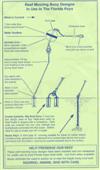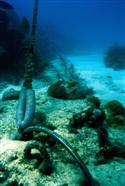

Life Savers For The Reef
Key West Reef Mooring Buoys

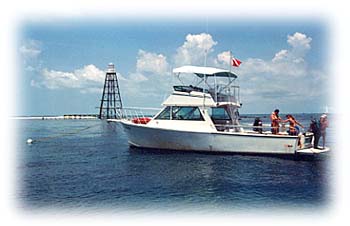
Photo courtesy Robert Gauthier
Key West Reef Mooring Buoy Program
Reef Relief installed a total of 116 reef mooring buoys at 7 Key West-area coral reefs and maintained them for a period of 10 years. It was the largest private mooring field in the world and was available to the public at no cost. Craig Quirolo designed innovations to the original system designed by John Halas and Harold Hudson of the sanctuary. His Big Boat U-bolt buoy accommodated larger boats. The self-cleaning buoy design greatly reduced maintenance expenses. The buoys are now part of the Florida Keys National Marine Sanctuary reef mooring buoy program. See chart of Florida Keys buoys.
If the biota, in the course of aeons, has built something we like but do not understand, then who but a fool would discard seemingly useless parts? To keep every cog and wheel is the first precaution of intelligent tinkering. Aldo Leopold, Round River, 1993.
Reef Relief Founders.com
Beginning in 1986, Reef Relief installed and maintained 116 mooring buoys at seven Key West-area coral reef that are still available for use at no cost to the public. The greatest advantage to reef mooring buoys is that they greatly reduce anchor damage to the living coral reef.
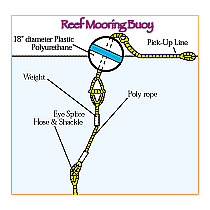
These buoys were officially transferred to the Florida Keys National Marine Sanctuary in October, 1997. The reef mooring buoys provide a safe and easy method of eliminating anchor damage by the world's largest fleet of charter boats. Boaters are encouraged to hook up to the buoys because they eliminate the need to drop anchor on the fragile living coral reef.
John Halas and Harold Hudson of the then Key Largo National Marine Sanctuary Program are responsible for designing the original single eyebolt reef mooring buoy system in use in the Keys. The design is efficient and only small core drillings are necessary to hold the eyebolts in place. Mantas were later installed at some rocky substrates where cores could not be installed. Craig Quirolo created the U-bolt or Big Boat Buoy that is in use throughout the Keys now to sustain use by vessels over 30'. He also designed the self-cleaning buoy, which has not been adopted by the sanctuary staff that currently maintains the buoys.
The polypropylene pick-up lines are treated for resistance to the damaging rays of the sun and are easily removed for replacement when necessary. The buoy itself floats on the surface and is recognizable from a distance. A reef tract surrounded by mooring buoys provides a warning to boaters that this is an area of shallow water that should be carefully and slowly navigated.
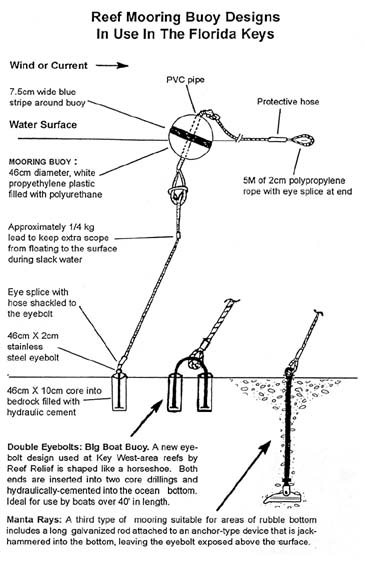

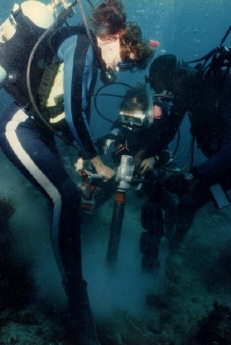
Mooring buoy with single eyebolt installed in fossilized coral substrate on the ocean floor.
Volunteers Karen McCarthy, Katy Thacker and Nuffy drill into fossilized coral during reef mooring installation at coral reefs in Negril, Jamaica.
Below left: The final product is easily identified at the reef since the buoy floats.
Below right: Craig's self cleaning buoy design features an extra piece of line on the outside of the buoy that works with the motion of the ocean to remove nuisance algal growth that creates most of the work in maintaining buoys in good working condition.

HOW TO USE MOORING BUOYS
- Slowly approach the buoy from down wind and/or down current.
- Smaller boats are encouraged to tie off to one another, thereby allowing larger vessels access to buoys. Remember, the larger the vessel, the more potential damage to the coral (if an anchor is used).
- All boats should put out extra scope by adding an extra line to create a horizontal pull on the eyebolt. Otherwise, the eyebolt will be pulled out. A good rule to remember is: if the buoy is pulled underwater, you must let out extra scope.
- Inspect the mooring buoy your boat is tied to -- you are still responsible for your vessel.
- Sailboats should not leave large sails up as steadying sails when on a buoy; this puts too much strain on the eyebolt.
If you choose not to use a mooring buoy, anchoring is only permitted in the sandy areas. DO NOT ANCHOR ON CORAL! This is Florida State Law and prohibited within Sanctuary Preservation areas of the Florida Keys National Marine Sanctuary.
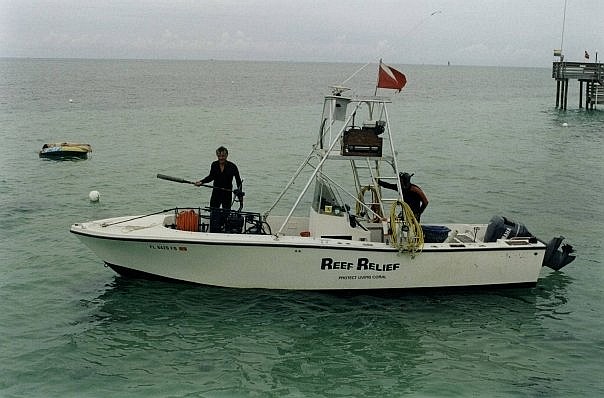
Pictured is Craig Quirolo installing demarcation buoys within the Key West Marine Park. The hydraulic drill and other equipment used to install reef mooring buoys can fit onto a small boat as noted.
Craig Quirolo directed the installation of Reef Relief reef mooring buoys at these coral reefs: Western Dry Rocks, Sand Key, Rock Key, Eastern Dry Rocks, Western Sambo, Pelican Shoal , Cottrell Key . There are also six mooring buoys installed by Reef Relief off Little Torch Key which are being maintained by Little Palm Island Resort.
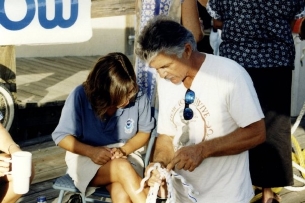

Reef Relief organized splicing parties in the Keys, Jamaica, Bahamas, Bay Islands and elsewhere where volunteers helped prepare buoys and line for the program. Left: Craig Quirolo works with Sanctuary staffer Cheva Heck at a Key West splicing party. Right photo: Negril, Jamaica volunteers learn to splice lines for the buoys.
Many other mooring buoys which have been installed and are also maintained by the Florida Keys National Marine Sanctuary throughout the Florida Keys. These are located at: Looe Key , Sombrero Reef off of Marathon , Islamorada reefs: Pickles Reef, Conch Reef, Little Conch, Davis Reef, Crocker, Hens & Chickens, Cheeca Rocks, Alligator, Key Largo reefs: Three Sisters, Molasses Reef, Sand Island, White Bank, Dry Rocks, French Reef, Benwood Wreck, Grecian Rocks, Key Largo Dry Rocks, The Elbow, Carysfort South, Carysfort Reef, Turtle Rocks, Turtle Shoals, Northeast Patch. The National Park Service maintains 18 demarcation and 5 reef mooring buoys at the Dry Tortugas National Park. Additional buoys have been installed since the following chart of buoys was produced by Reef Relief but these represent the major coral reefs where buoys are available for public use.
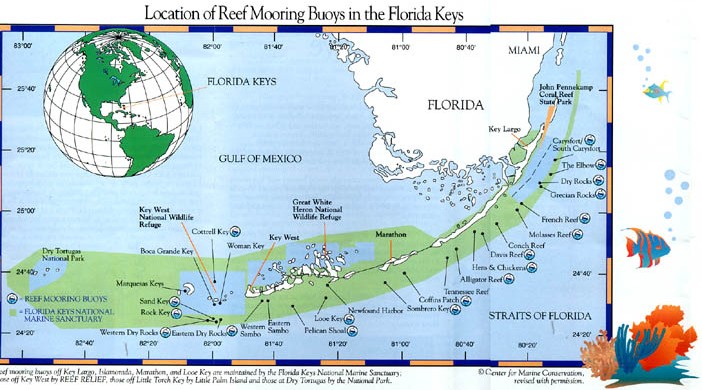

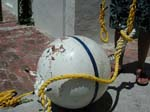
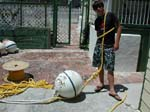
Photo: Carter Sarrett buoy
Caption: In May, 2004, Carter Sarrett of Alpharetta, Georgia, was an intern at Reef Relief with Craig Quirolo. He is pictured here with a newly-spliced buoy component. They have been inspecting and replacing buoys in the 18-buoy Green Turtle Cay Mooring Buoy system.
Photo: Self Cleaning Buoy
Caption: This shows the self-cleaning buoy invented by Craig Quirolo. An additional line is spliced to the top and bottom outside of the buoy float. The motion of the ocean moves the line on the buoy, preventing nuisance algal growth.
U-Bolt (left) for mooring larger boats
(Click the Image to open in a new window)
Pictured is the U-bolt, with the line attached that leads to a floating reef mooring buoy on the surface of the water. The Ubolt was first designed by Craig Quirolo to accommodate larger boats using the reef mooring buoy system off Key West. You can also see the original single eyebolt that was installed originally nearby it by Reef Relief. This upgrade strengthened the system considerably. This design has been adopted by the Florida Keys National Marine Sanctuary.


